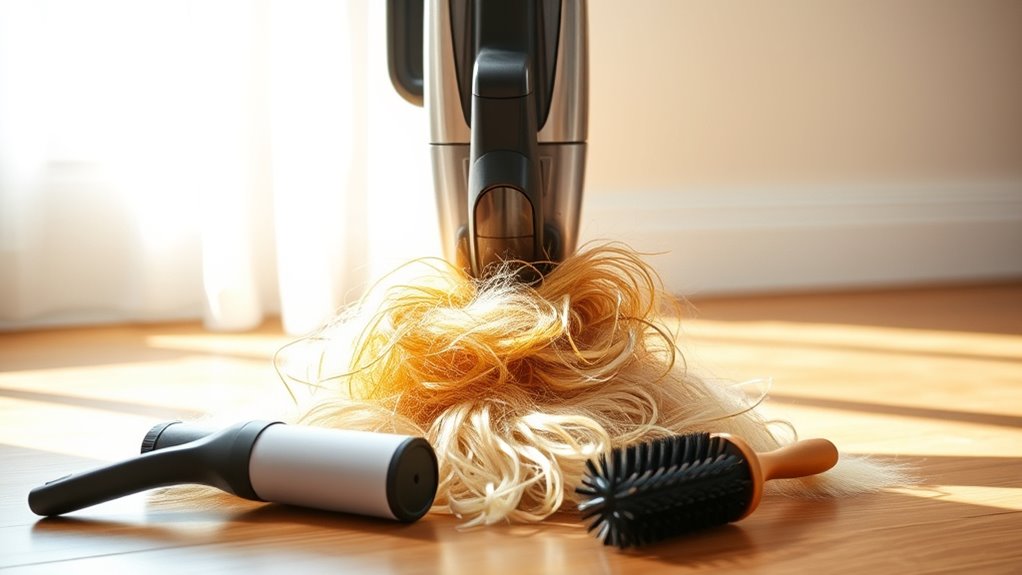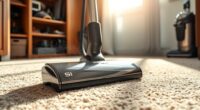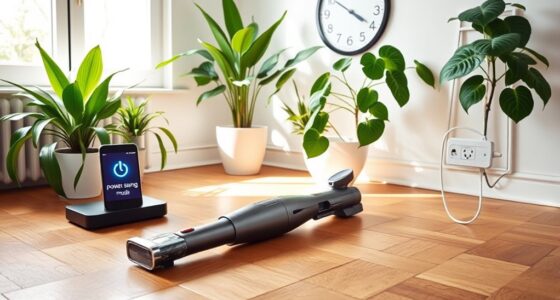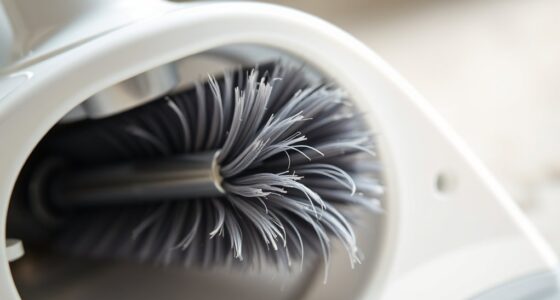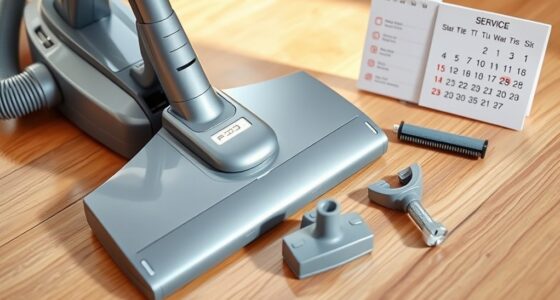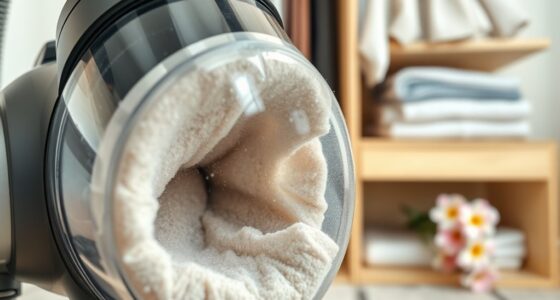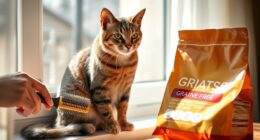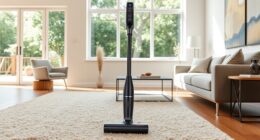Pet hair can really affect your vacuum’s performance. It clogs bags and filters, causing reduced suction and potential motor burnout. To manage this, choose a vacuum with strong suction and specialized attachments for pet hair. Regular maintenance is essential—empty the dustbin daily, clean the filters weekly, and inspect brush rolls to prevent tangling. By taking these steps, you’ll keep your vacuum running efficiently. Discover more strategies for effective pet hair management and air quality improvement.
Key Takeaways
- Pet hair can clog vacuums, reducing suction and efficiency; specialized vacuums handle fine, sticky hair better with stronger suction and tangle-free systems.
- Regular maintenance, including cleaning filters and brush rolls, is essential to prevent overheating and maintain optimal vacuum performance.
- Use specialized attachments, like upholstery tools and crevice tools, to effectively tackle embedded pet hair in carpets and furniture.
- HEPA filters are crucial for trapping allergens; ensure they are cleaned or replaced regularly to maintain airflow and suction.
- Incorporate proactive measures, such as frequent pet brushing and designated pet-free zones, to reduce shedding and manage hair accumulation effectively.
Understanding the Impact of Pet Hair on Vacuum Performance
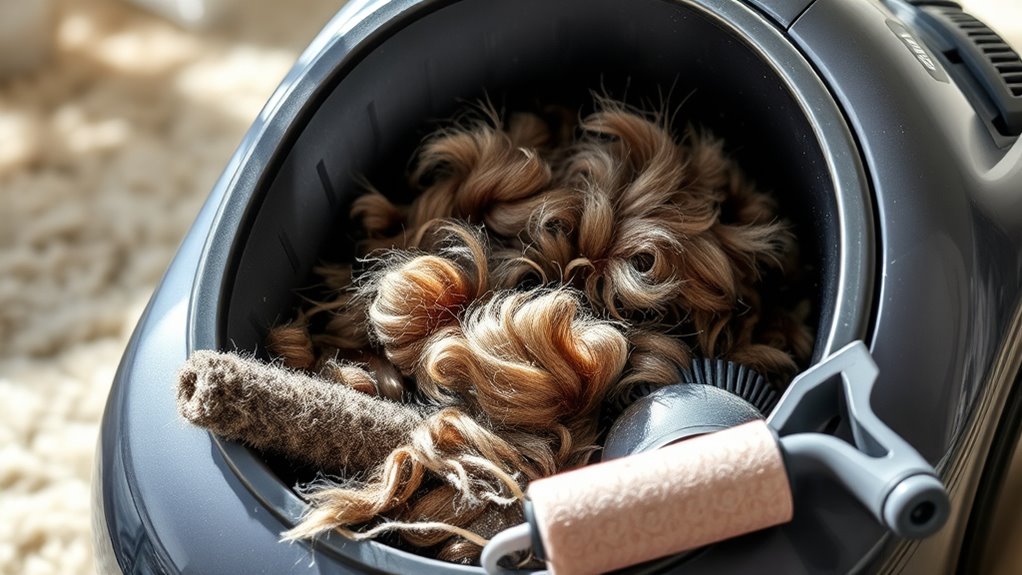
When you have pets, the impact of their hair on your vacuum’s performance can be significant. Pet hair can clog vacuum bags and filters, drastically reducing suction power and cleaning efficiency.
Standard vacuums often struggle with this fine, sticky hair, leading to potential motor burnout and a shorter lifespan. To tackle these challenges, consider using specialized vacuums equipped with stronger suction and tangle-free brush systems.
These models often come with HEPA filters, which not only capture pet hair but also reduce allergens, creating a healthier home. To maintain peak vacuum performance, regular maintenance is key.
Make sure to clean filters and remove hair tangles frequently to keep your vacuum running at its best.
The Importance of Regular Vacuum Maintenance
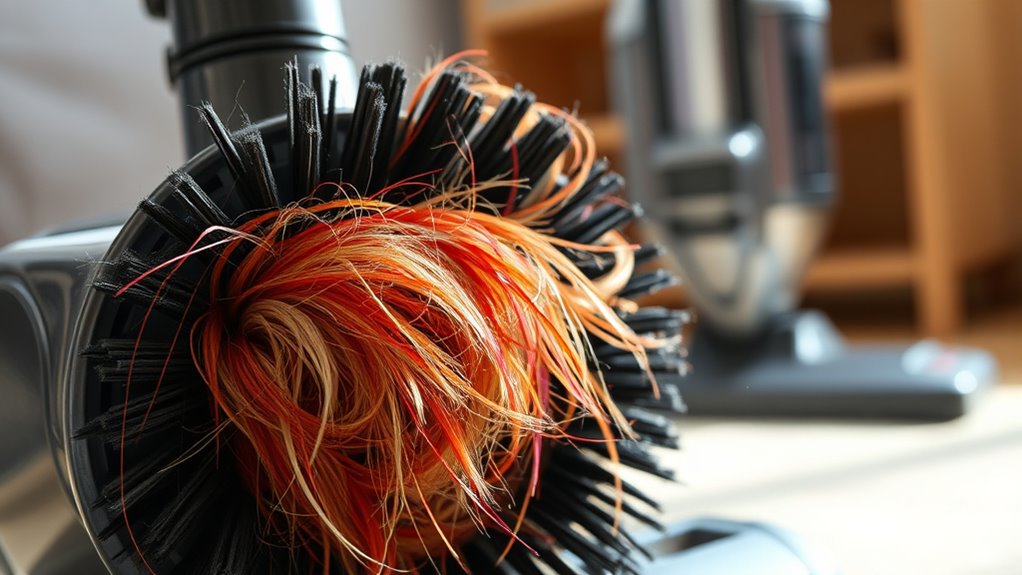
To keep your vacuum running at its best, regular maintenance is key. Cleaning the filters and checking the brush rolls for tangles will guarantee that you maintain peak suction power and performance. Additionally, ensuring that your vacuum can handle pet hair effectively will enhance its longevity and efficiency. Regular maintenance is especially important for vacuums for pet hair, as they are designed with specific features to tackle pet-related debris.
Regular Filter Cleaning
Regular filter cleaning is essential for maintaining your vacuum’s performance, especially if you’re tackling pet hair. Clogged filters can drastically reduce suction and cleaning efficiency, making it harder to pick up stubborn pet dander and hair.
To keep your vacuum running smoothly, check and clean vacuum filters every 1-3 months, depending on how often you groom your pets. HEPA filters, when properly maintained, can trap up to 99.97% of particles, ensuring peak airflow and preventing allergens from escaping back into your home.
Neglecting filter maintenance can lead to overheating and motor burnout, shortening your vacuum’s lifespan. By prioritizing regular filter cleaning, you’ll enhance your vacuum’s performance and create a healthier environment for you and your pets.
Brush Roll Maintenance
Keeping your vacuum in prime shape goes beyond just filter cleaning; brush roll maintenance plays a significant role in its effectiveness, especially in homes with pets.
Regularly inspecting your brush roll helps prevent tangled pet hair from reducing suction power. A clogged brush roll can lead to overheating, risking damage to the motor and shortening your vacuum’s lifespan.
To guarantee peak vacuum performance, aim to remove hair and debris weekly. If your vacuum has a removable brush roll, take advantage of this feature for thorough cleaning without needing specialized tools.
Additionally, consider models with anti-tangle features to minimize hair accumulation, reducing how often you need to perform maintenance. Keeping up with brush roll care guarantees your vacuum runs at its best.
Selecting the Right Vacuum for Pet Hair Removal
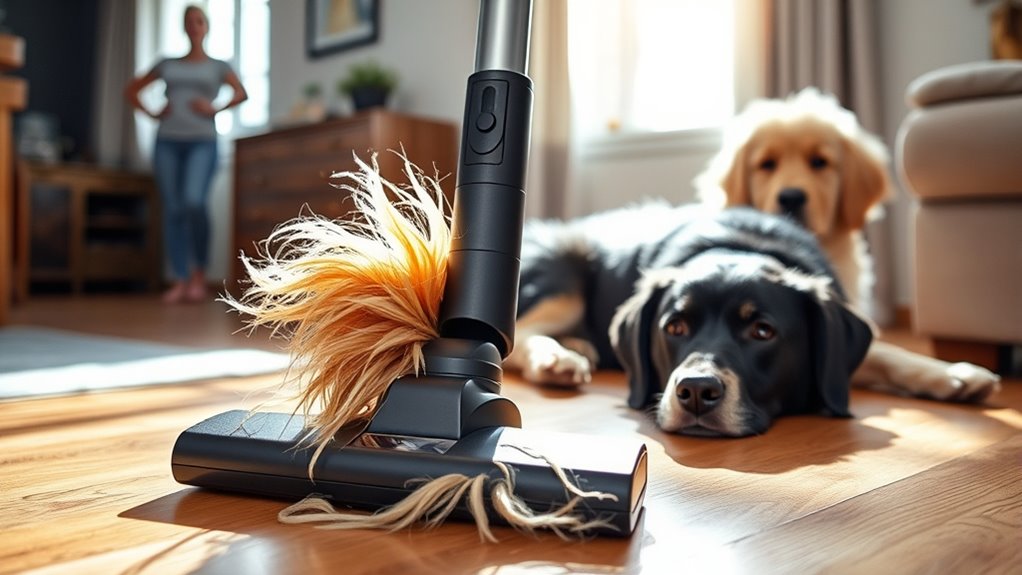
When you’re choosing a vacuum for pet hair removal, it’s essential to look for specific features that enhance performance.
Avoid common pitfalls, like opting for standard models that struggle with fine hair, and make sure you consider attachments and filtration systems.
This way, you can effectively tackle pet hair while improving your home’s air quality.
Essential Features for Selection
Selecting the right vacuum for pet hair removal can make a significant difference in your cleaning routine, so it’s crucial to focus on essential features that enhance efficiency.
Look for models with powerful suction designed to lift fine pet hair from carpets and upholstery, as ordinary vacuums often struggle. Opt for vacuums that come with specialized pet hair attachments like turbo brushes, which improve cleaning efficiency by agitating fibers and gripping hair.
HEPA filtration systems are a must, capturing allergens and dander to boost air quality. Consider bagless vacuum designs for consistent suction power and easy emptying.
Finally, verify the vacuum has maintenance features like washable filters and accessible brush rolls to manage pet hair buildup effectively. Additionally, many of the top rated vacuums of 2024 include innovative technology that enhances cleaning performance.
Common Pitfalls to Avoid
Even with the right features in mind, many pet owners still make mistakes that can hinder their vacuum’s performance.
One common pitfall is choosing a vacuum cleaner without specialized pet hair attachments, which often leads to clogged brushes and ineffective cleaning. Additionally, many energy-efficient appliances are designed to minimize power consumption, which can be beneficial for households with pets. Selecting a vacuum with strong suction power is crucial for effectively removing pet hair from various surfaces.
Budget models typically lack the suction power needed for fine pet hair, risking motor damage over time. Don’t overlook the importance of HEPA filtration; it captures pet dander and improves air quality.
Opt for vacuums with easy-to-empty dustbins to simplify maintenance, essential for managing pet hair. Finally, regularly inspect and maintain your vacuum’s components for peak performance.
Additionally, consider vacuums from top-rated brands known for their effectiveness in handling pet hair. Avoid these mistakes, and you’ll enhance your cleaning process and tackle pet hair like a pro.
Common Challenges Faced by Pet Owners
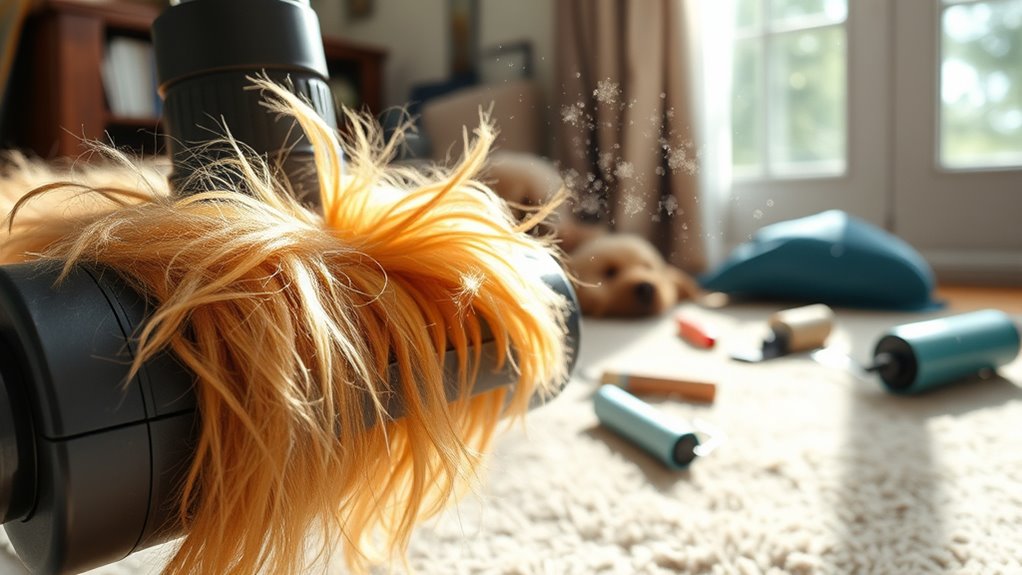
As a pet owner, you quickly realize that managing pet hair can be a daily struggle that impacts your home environment.
Standard vacuum cleaners often struggle with fine pet hair, which can clog filters and reduce suction power. If you don’t manage this effectively, you risk potential motor burnout. Frequent shedding, especially from certain breeds, adds to your cleaning routine, requiring more frequent filter cleaning and dustbin emptying.
Plus, pet dander can aggravate allergies, making vacuums with HEPA filters indispensable for better air quality. To tackle embedded hair in carpets and upholstery, using specialized attachments is vital.
Regularly implementing these strategies helps you maintain a cleaner home while reducing the challenges associated with pet hair.
Effective Vacuuming Techniques for Pet Hair
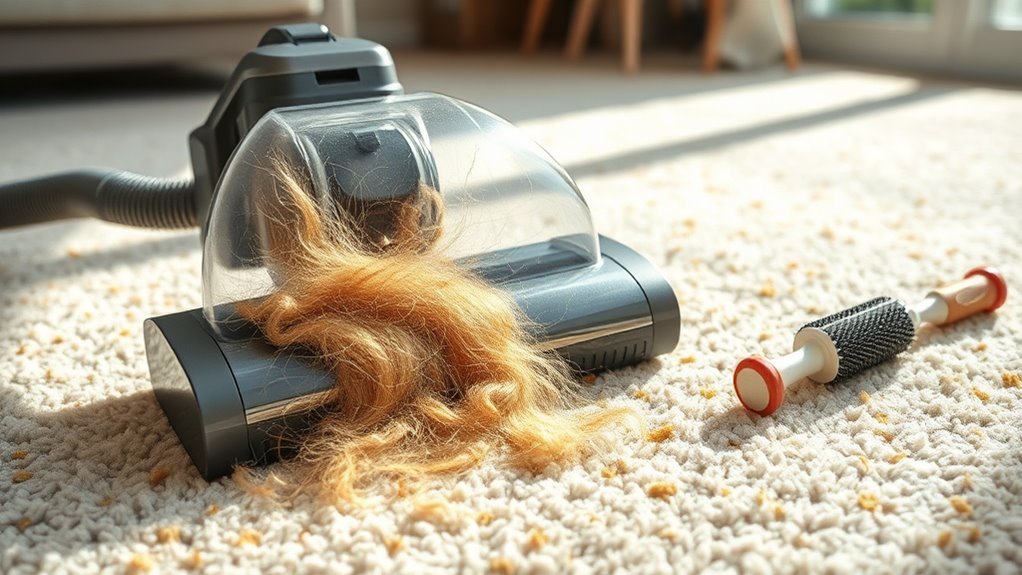
To tackle pet hair effectively, you need to adjust your vacuum settings for ideal performance.
Use specialized attachments like rubber bristle tools to capture hair from furniture and tight spaces.
Optimal Vacuum Settings
When you’re tackling pet hair, adjusting your vacuum settings is crucial for effective cleaning. Start by setting your vacuum to a high-suction level; this helps lift embedded hair from carpets and upholstery.
If you have a pet hair attachment, use it to agitate and extract stubborn pet hair more efficiently. Make multiple passes over high-shedding areas with slow, deliberate strokes to guarantee thorough cleaning. Additionally, regular grooming can significantly reduce the amount of shedding fur that accumulates in your home. Using a vacuum designed for dust removal can also enhance your cleaning routine. Air purifiers with HEPA filters can further assist in maintaining a clean environment by capturing airborne pet dander.
Consider lightly misting upholstery with water before vacuuming, as this helps clump the hair, making it easier to pick up.
To maintain ideal airflow and suction power, regularly clean or replace your filters and check for clogs in hoses or attachments. This proactive approach will greatly enhance your vacuuming efforts against pet hair. Additionally, using a vacuum with strong suction power will ensure that even the finest hair is effectively removed from your home’s surfaces.
Specialized Attachments Usage
Maximizing your vacuum’s effectiveness against pet hair starts with using specialized attachments.
Utilize specialized brush tools designed to agitate and lift embedded fur from carpet fibers, ensuring thorough cleaning results. For your furniture, pet hair upholstery tools with rubber bristles grab and remove hair efficiently, enhancing your cleaning effectiveness.
Don’t forget about crevice tools; they’re perfect for reaching tight spaces where pet hair collects, like corners and between furniture. Extension wands are also essential for cleaning high surfaces, allowing you to capture hair on shelves and light fixtures. Additionally, using a vacuum with HEPA filters can help reduce allergens in the air caused by pet dander.
Utilizing Specialized Attachments for Better Results
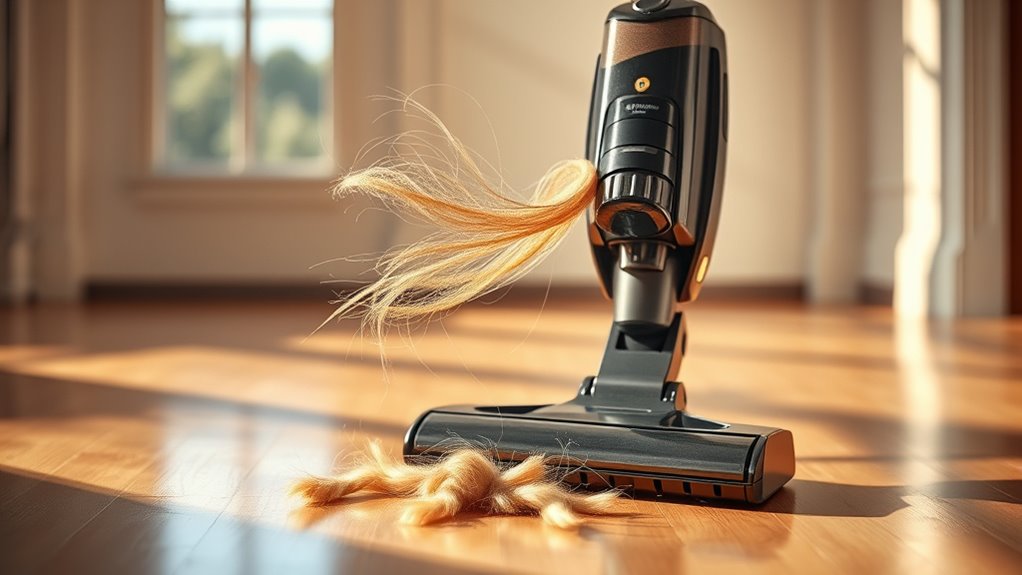
While standard vacuum attachments can handle everyday dirt and debris, pet owners often find that specialized attachments are the key to truly effective cleaning. These tools enhance cleaning efficiency, making them invaluable for tackling pet hair. Regular cleaning of air purifiers is also essential to maintain a healthy home environment, as improving air quality can help reduce allergens in your home. Keeping your air purifier in a low humidity area can further enhance its effectiveness in reducing pet-related allergens.
| Attachment Type | Purpose |
|---|---|
| Pet Hair Upholstery Tools | Grip and pull hair from furniture with rubber bristles |
| Brush Tools | Lift embedded fur from carpets |
| Crevice Tools | Clean tight spaces like between cushions and baseboards |
| Extension Wands | Reach high surfaces and hard-to-reach areas |
Utilizing these specialized attachments not only improves vacuuming performance but also helps maintain better air quality by reducing allergens like pet dander and fur in your home. Embrace these tools for a cleaner, healthier living environment for you and your pets! Additionally, many of these attachments are particularly effective when paired with the best home security systems to ensure a comprehensive approach to household care and protection.
Daily and Weekly Maintenance Routines
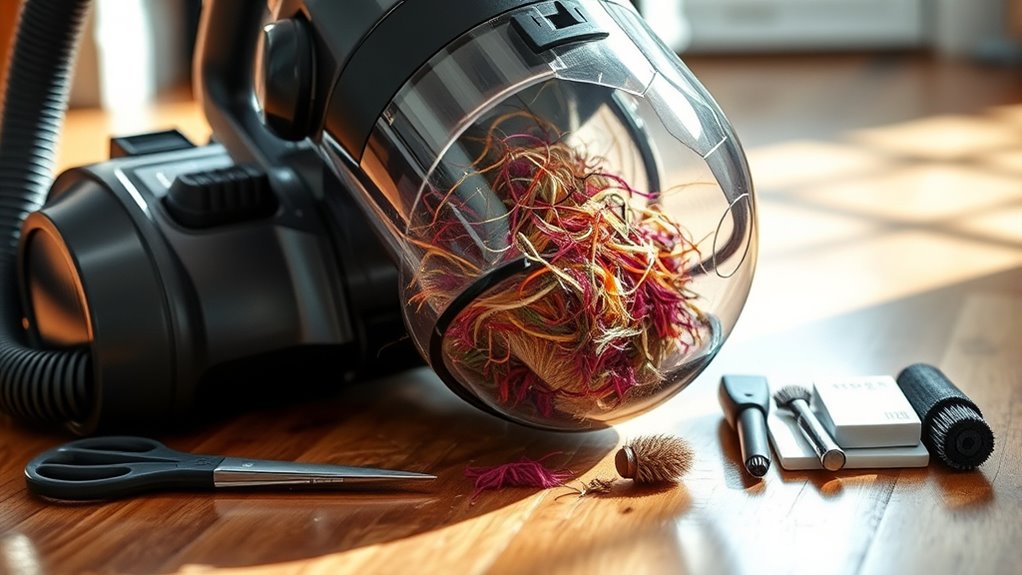
Specialized attachments can considerably enhance your vacuuming experience, but even the best tools need regular upkeep to perform at their finest.
As a pet owner, establishing daily and weekly maintenance routines is essential. Here’s how to keep your vacuum in top shape:
- Daily: Empty the dustbin or change the bag to maintain peak suction power, especially with pet hair.
- Daily: Vacuum high-traffic areas and pet resting spots to minimize allergens.
- Weekly: Clean vacuum filters and brushes to prevent clogs caused by pet hair.
- Weekly: Incorporate vacuuming into your cleaning routine, using a rotating brush attachment for carpets.
Don’t forget to use a lint roller for quick clean-ups on furniture and clothing between deep cleaning sessions!
Deep Cleaning Strategies for Long-Term Care
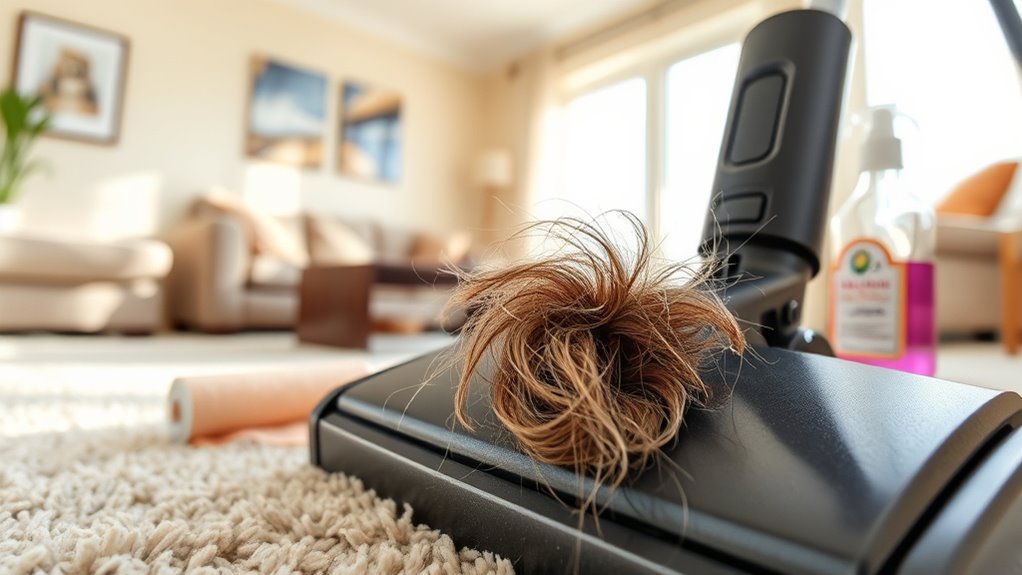
To maintain your vacuum’s efficiency over the long term, it’s essential to implement deep cleaning strategies that target pet hair buildup.
Regularly deep clean your vacuum by removing pet hair from the brush rolls, as tangled hair can hinder performance and cause overheating. Air purifiers can also help manage allergens in your home, making it easier to keep surfaces clean. Additionally, using a vacuum cleaner with HEPA filters can enhance air quality by capturing allergens released during cleaning. Proper pet grooming can significantly reduce the amount of hair shed in your home, making vacuuming more manageable.
Don’t forget to clean filters and empty dust bins monthly; clogged filters reduce suction power, making it harder to manage pet hair.
Focus on hard-to-reach areas, like beneath furniture and along baseboards, where pet hair often accumulates.
Invest in specialized attachments, such as rubber bristle tools, to effectively agitate fabric surfaces and lift embedded pet hair during deep cleaning sessions.
Consistent maintenance guarantees your vacuum remains effective against pet hair over time. Additionally, understanding common issues related to vacuum performance can help you address problems before they escalate.
Proactive Measures to Minimize Pet Hair Accumulation
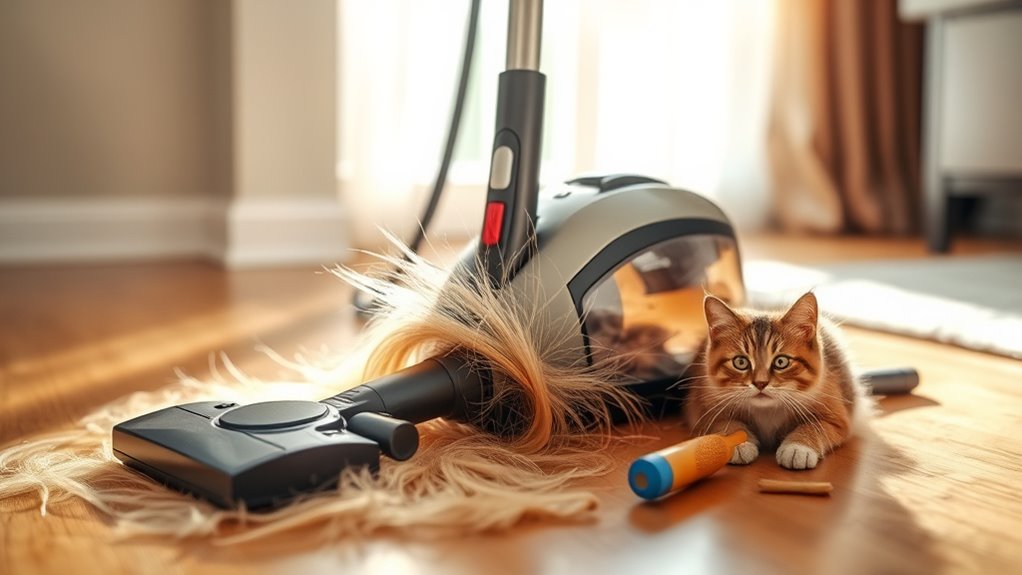
Managing pet hair in your home can feel overwhelming, but by taking proactive measures, you can considerably reduce its accumulation.
Here are some effective strategies to help you minimize pet hair:
- Frequent Brushing: Regularly groom your pet to capture loose fur and reduce shedding.
- Designated Pet-Free Zones: Create areas in your home where pets aren’t allowed, limiting hair accumulation.
- Use Seat Covers: Utilize specially designed covers in your car to catch hair before it reaches your upholstery.
- Choose Hair-Resistant Furnishings: Opt for furniture and hard flooring that make removing pet hair easier.
Tips for Enhancing Indoor Air Quality
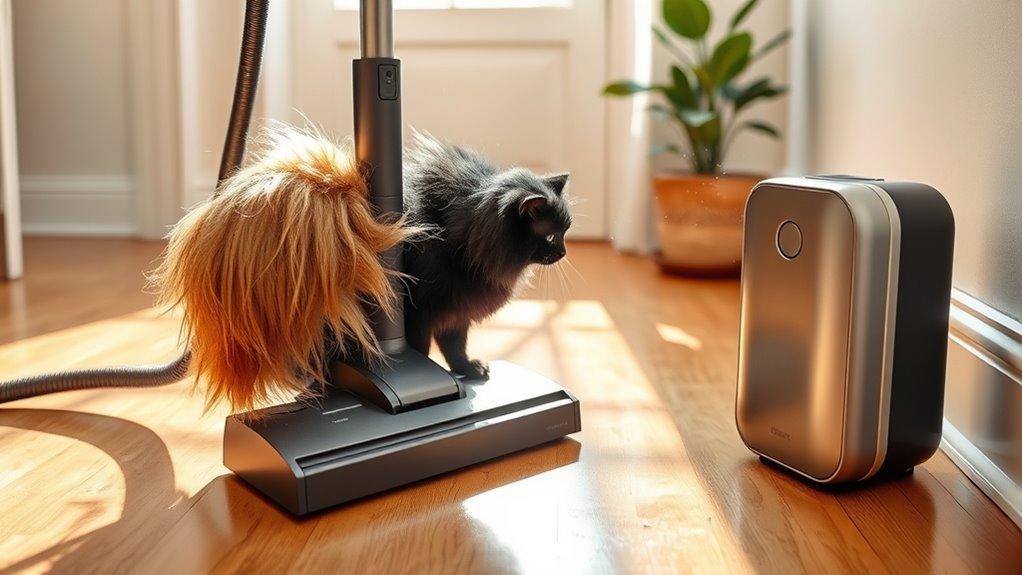
While pet ownership brings joy, it can also impact your indoor air quality if not managed properly.
To enhance your home’s air quality, start by using a vacuum equipped with HEPA filters. These filters capture 99.97% of particles, including pet hair and dander, improving air quality. The presence of security systems can also provide peace of mind, allowing you to focus on maintaining a clean home. Additionally, using heat pumps can improve indoor air quality through better humidity control and advanced filtration systems. Incorporating an air purifier with HEPA filter technology can significantly reduce allergens and improve the overall air quality in your home.
Maintain a consistent cleaning schedule, focusing on high-traffic areas and your pet’s favorite spots to minimize hair accumulation. Regular grooming is essential too; it helps reduce shedding, which means fewer allergens in the air. Additionally, using products like best root lifters for fine hair can help create a cleaner environment by minimizing hair fallout.
Don’t forget proper ventilation—open windows or invest in air purifiers with HEPA filters to combat airborne pet allergens.
Frequently Asked Questions
Does Dog Hair Ruin a Vacuum?
Yes, dog hair can ruin a vacuum if you don’t manage it properly. It clogs hoses and filters, diminishing suction and efficiency over time.
If you’ve got a standard vacuum, it might struggle with fine dog hair, leading to potential motor burnout.
To keep your vacuum running smoothly, clean filters regularly and remove hair from brush rolls.
Investing in a specialized vacuum designed for pet hair can also make a big difference in performance.
What Is the Best Vacuum for Excessive Pet Hair?
When you’re searching for the best vacuum for excessive pet hair, prioritize models with strong suction and turbo brushes.
HEPA filters can help capture allergens, improving your home’s air quality.
Consider bagless options for hassle-free cleaning, and don’t forget specialized attachments like pet hair tools for upholstery and crevice cleaning.
Checking reviews from Consumer Reports can guide you in choosing a reliable vacuum that tackles pet hair effectively.
Does Hair Damage a Vacuum Cleaner?
Yes, hair can definitely damage a vacuum cleaner.
If you don’t regularly remove hair from the brush rolls and filters, it can lead to clogs and reduced suction. Over time, this buildup can cause the motor to overheat and even fail.
Plus, tangled hair can wear down the brushes, making them less effective. To keep your vacuum running smoothly, make it a habit to clean out any hair regularly.
How to Vacuum Stubborn Dog Hair?
To vacuum stubborn dog hair effectively, use a vacuum designed for pet hair, as it has stronger suction and specialized attachments.
Make multiple slow passes over trouble spots to lift embedded hair. Lightly mist upholstery with water before vacuuming to help clump the hair together.
Regularly clean your vacuum to maintain suction, and for those extra stubborn strands, try using rubber gloves to gather any remaining hair easily.
Conclusion
In the battle against pet hair, your vacuum is your trusty sidekick. By understanding its needs and implementing regular maintenance, you can keep it performing at its best. Remember, a little proactive care goes a long way in minimizing pet hair buildup and enhancing your indoor air quality. So, why let pet hair take over when you can take charge? With the right techniques and routines, you’ll create a cleaner, healthier home for both you and your furry friends.
